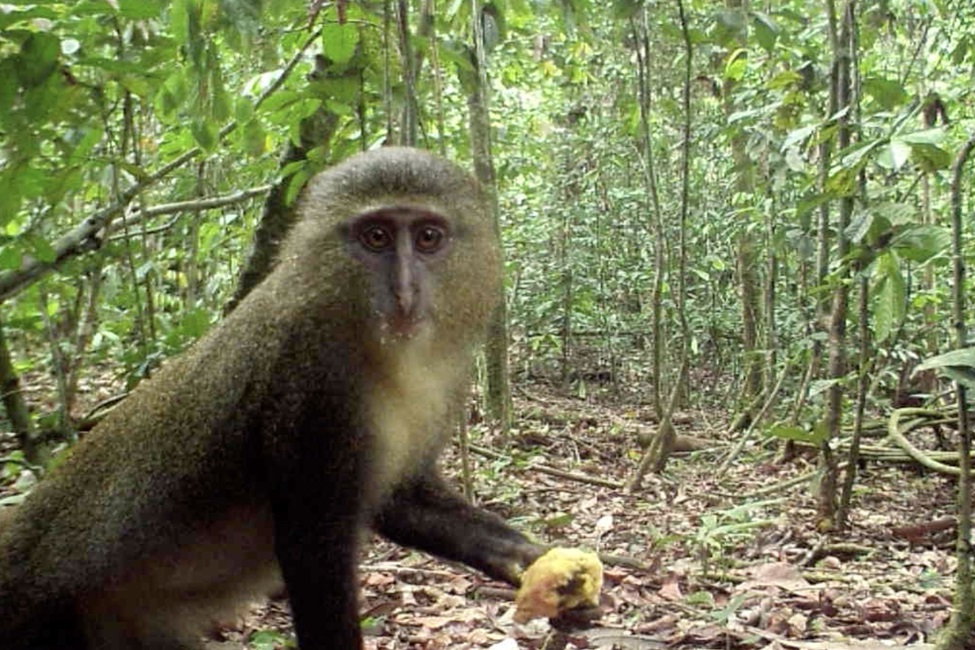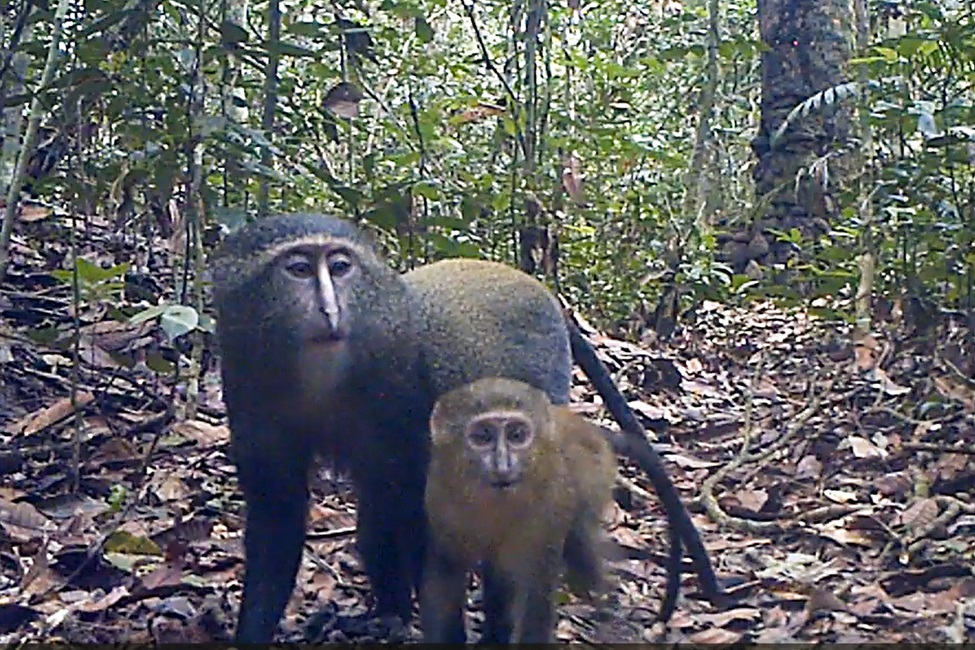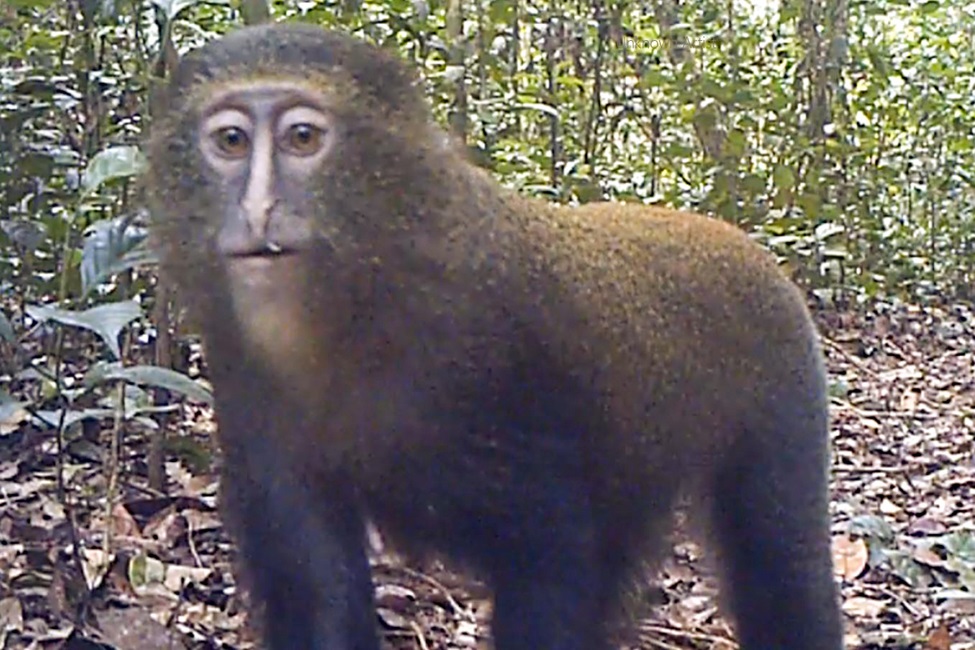Camera Traps Uncover Mysterious Lesula Monkey's 'Business'

Strategically placed camera traps have uncovered the mysterious behavior of an elusive species of African monkey – Cercopithecus lomamiensis, commonly known as the “lesula.”
In much the same way that Ring home security cameras capture both mundane and extraordinary events, strategically placed camera traps have uncovered the mysterious behavior of an elusive species of African monkey – Cercopithecus lomamiensis, commonly known as the “lesula.” With its large human-like eyes, golden mane and pink face, this cryptic species was discovered in 2012 in the central Congo Basin in the Democratic Republic of the Congo.
Because of the lesula’s mysterious behavior, traditional observational methods in the field are challenging. To date, no behavioral study has been done to evaluate this species’ degree of terrestriality.
To address a lack of comprehensive ecological knowledge on this lineage, Florida Atlantic University researchers were the first to design and employ an intensive camera trap study to document the lesula’s terrestrial movement, daytime activity pattern, birth seasonality, group size and social organization.
Camera traps, equipped with infrared sensors to automatically and non-invasively capture videos, provided the researchers with the best approach to estimate group counts from non-habituated lesula individuals without any disturbance to their social groups.
For the study, a collaborative research team established two systematic camera trap grids inside the Lomami National Park within the Democratic Republic of the Congo in Central Africa and one outside the park in the buffer zone, where the animals are heavily hunted. The research team conducted three systematic, terrestrial camera trap surveys and accumulated 598 independent events of lesula over 5,960 camera trap days from 92 camera traps over a three-year period.
Results of the study, published earlier this year in the journal Animals , reveal that the lesula’s locomotor behavior is highly terrestrial, has a daytime or diurnal activity pattern, and lives in medium to large groups with one adult male, multiple adult females and their juveniles. The average group size from the three surveys combined was 7.7 individuals.
The highest peaks in birth occurred from August through October, which overlaps with the start of the second wet season in the region.
Combining all surveys, researchers recorded a total of 2,298 individuals: 1,163 were mature adult males and females, 696 were juveniles/infants/immature males and females. Lesula groups were comprised of multiple females with their infants and juveniles. Researchers also recorded single males and male-only groups comprising up to three males, which they identified as “bachelor” groups.
Results indicate that lesula groups mostly contain single males; however, some larger groups contained two mature males. Overall, 45 percent of all males identified were either lone males or in male-only groups.
“There is growing recognition of the importance of incorporating life history and behavioral data of threatened species into wildlife management practices,” said Kate M. Detwiler, Ph.D., senior author and an associate professor of biological sciences in FAU’s Charles E. Schmidt College of Science, who was part of the research team that discovered the lesula. “Because camera traps can run independently when field researchers are not present, they contribute to conservation efforts by providing new approaches to collect life history and behavioral data, which can be applied to wildlife management.”
For the study, researchers determined the group size and composition for each event by identifying a minimum number of unique individuals based on age, sex, and/or physical features, as well as their position and directionality of movement in the videos. Physical features included unique markings, such as scars and kinked tails. They estimated age-class (infant, juvenile, or subadult/adult) and sex (male, female). They defined a social group as three or more individuals with at least one female or juvenile present.
“Unlike other Cercopithecus species that mostly live in trees, our research indicates that the lesula spend most of their time on the forest floor,” said Charlene S. Fournier, first author, an FAU Ph.D. student in integrative biology, and a researcher in the Asghar Lab – Micro and Nanotechnology in Medicine, FAU Department of Electrical Engineering and Computer Science, within the College of Engineering and Computer Science. “Our survey results also suggest that lesula live in groups larger than previously reported from direct observations in the field with up to 32 individuals.”
Study co-authors are Steven McPhee, an FAU anthropology graduate and teaching assistant; and Junior D. Amboko, a field conservationist from the Democratic Republic of the Congo and an FAU anthropology graduate student, both within the Dorothy F. Schmidt College of Arts and Letters.
This research was funded by Primate Conservation Inc. (PCI No. 1122), Idea Wild, FAU Anthropology Department, Indiegogo Crowdfunding, and TL2 Project of the Lukuru Wildlife Research Foundation.
//
Camera traps equipped with infrared sensors automatically and non-invasively captured videos of Africa’s lesula monkey in the central Congo Basin in the Democratic Republic of the Congo without any disturbance to their social groups.


-FAU-
Latest Research
- Suicide Risk Elevated Among Young Adults with DisabilitiesSuicide is the third leading cause of death in young adults. For those with intellectual and developmental disabilities, the crisis is worse. New research urges prevention, screening and intervention reforms.
- In Stereo: Neurons Shift Gears Between Thoughts Using Brain RhythmsAn FAU study provides a new understanding of how the brain organizes thoughts for navigation, memory and behavior - offering insights into neurological conditions like epilepsy, Alzheimer's and schizophrenia.
- FAU's CA-AI Makes AI Smarter by Cleaning Up Bad Data Before It LearnsFAU engineering researchers from the CA-AI have developed a method to automatically detect and remove label noise from data before training begins, resulting in smarter, faster and more reliable AI.
- Logistics Leaders See Tight Capacity, High Prices Through Mid-2026The Logistics Managers' Index rose for the second consecutive month due to rising costs as the economy remains uncertain, according to researchers at Florida Atlantic University and four other schools.
- Green Seaweed Replaces Seagrass, But Sea Slugs Pose New ThreatsFAU Harbor Branch researchers found that Caulerpa prolifera has taken over seagrass in the Indian River Lagoon, reducing biodiversity, and recently raising concerns over rising numbers of sap-sucking sea slugs.
- To Build Muscle and Gain Strength, Train Smarter - Not LongerThink you need marathon gym sessions to build muscle? Think again. Less is more, according to a study by FAU exercise scientists, which confirms ditching long gym sessions will still show real results.






